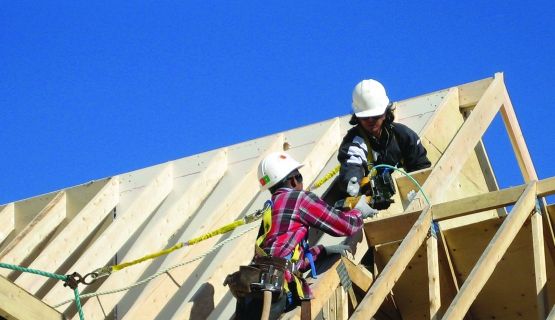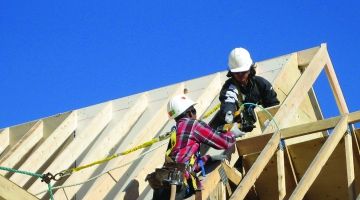Health and safety training
IWH research on occupational health and safety (OHS) training focuses on its effectiveness—from the effectiveness of delivery methods and contents to the effectiveness of training programs overall. OHS training, mandated by workplace health and safety laws in jurisdictions across Canada and beyond, is considered an important part of managing workplace hazards and risks. Such training may involve instruction on identifying occupational risks and how to control them, learning about safe workplace practices and how to properly use personal protective equipment.
Featured

Research Highlights
In-person or online: Does it make a difference for OHS training?
Online formats for occupational health and safety (OHS) training have gained popularity in recent years, especially since the COVID-19 pandemic. But are they as effective as in-person training?
Published: April 4, 2025

Impact case study
IWH evaluation of the effectiveness of the Ontario working-at-heights training standard
An IWH study on the effectiveness of Ontario's mandatory training was valuable to the labour ministry in several ways—including in reinforcing the value of program evaluations.
Published: November 21, 2023
Project
Project
Evaluating hazard awareness and mitigation training in Northern Ontario workplaces
This mixed-methods study seeks to evaluate hazard awareness training delivered by Workplace Safety North to up to 10 workplaces. Workplace Safety North is a Health and Safety Association funded by the province of Ontario, with a focus on businesses in Northern Ontario.
Status: Ongoing

IWH in the media
New funding announced for worker safety in mining and forestry
In what was described as a strategic, provincewide collaboration, the WSIB has partnered with Workplace Safety North (WSN) and the Institute for Work and Health (IWH) to lead a proactive campaign aimed at enhancing hygiene monitoring practices and reducing exposure to harmful workplace hazards. The initiative, spearheaded by WSN, is to focus on high-risk sectors such as mining and forestry, where workers continue to face some of the highest rates of occupational illness fatalities in Ontario. WSN has developed a suite of specialized training materials and will work directly with employers and workers through hands-on coaching and real-time use of hygiene monitoring equipment. The IWH will support the initiative by applying its expertise in health and safety research to assess the effectiveness of the training programs and their impact on improving worker safety.
Published: Sudbury.com, May 2025

IWH in the media
WSIB to spend $6.7M to protect workers in natural resources sectors
On Day 1 of the Mining Health and Safety Conference in Sudbury, the Workplace Safety and Insurance Board announced $6.78 million to protect workers in Ontario’s natural resources sectors, to be conducted by Workplace Safety North and the Institute for Work and Health, Lyndsay Aelick reports.
Published: CTV News, April 2025

Research Highlights
In-person or online: Does it make a difference for OHS training?
Online formats for occupational health and safety (OHS) training have gained popularity in recent years, especially since the COVID-19 pandemic. But are they as effective as in-person training? An IWH study compared online and in-person OHS training programs to measure differences in knowledge retention and whether learners felt they would use the knowledge they gained.
Published: April 2025
Journal article
Journal article
Differences in the effectiveness of three OHS training delivery methods
Published: American Journal of Industrial Medicine, April 2025

IWH in the media
Supervisor competence and support critical for safer, healthier workplaces
Competent and supportive supervisors can help reduce injuries experienced by workers, especially when supervisors are properly trained, states article that cites research by the Institute for Work & Health (IWH). It found that workers most likely to suffer an injury were those who reported that their supervisors were unaware of hazards and/or didn’t provide reasonable protection.
Published: Workers Health & Safety Centre, March 2025
Journal article
Journal article
Evaluation of the Ontario mandatory working-at-heights training requirement in construction, 2012 - 2019
Published: American Journal of Public Health, January 2024

Impact case study
IWH evaluation of the effectiveness of the Ontario working-at-heights training standard
An IWH study on the effectiveness of Ontario's mandatory training was helpful to the labour ministry in several ways—including in reinforcing the value of program evaluations.
Published: November 2023

IWH in the media
Study shows worker injuries due to falls from heights declined after Ontario made training standardized and mandatory
Among recent organized efforts to make jobsites safer, working-at-heights training has been effective, reports an Institute for Work & Health (IWH) study. As Adam Freill reports, in the three-year period after Ontario made working-at-heights training in the construction sector standardized and mandatory, study authors explain that the rate of fall-from-height injuries leading to time off work fell by 19 per cent.
Published: On-Site Magazine, November 2023
News release
News release
Worker injuries due to falls from heights declined after Ontario made training standardized and mandatory, study finds
Published: November 2023